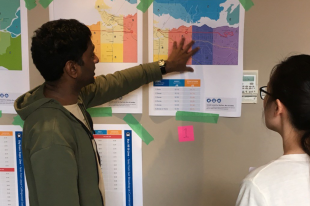Public Admin Explainer: “Public policies and programs are intended to improve the lives of citizens, so how can we ensure that they are as well-designed as possible?
In a recent article in Policy Design and Practice, ANZSOG’s Professor Michael Mintrom and Madeline Thomas explore the neglected connection between design thinking and the successful commissioning of public services.
Prof. Mintrom and
Design thinking encourages end-users, policy designers, central departments, and line agencies to work in a collaborative and iterative manner.
The most important skill for a design thinker is to “imagine the world from multiple perspectives – those of colleagues, clients, end-users, and customers”. This is where greater empathy for different perspectives emerges.
Design thinking does not start with a presumption of a known answer or even a well-defined problem. Through iterative ethnographic methods, design thinking can reduce gaps between the goals of policymaking and the experiences of citizens as they interact with government-funded services.
This kind of design thinking can be pursued through a range of techniques:
- Environment Scanning: This strategy explores present
behaviours of individuals and groups in given localities and the outcomes resulting from thosebehaviours . It also seeks to identify trends that may influence future outcomes. Used appropriately, it creates an evidence-based method of gathering,synthesising , and interpreting information, which can shift the attention of anorganisation towards new opportunities, threats, and potential blind spots. - Participant Observation: While environment scanning facilitates the broad exploration of an issue, observation requires engaging with people encountering specific problems. Participant observation can access tacit, otherwise, difficult-to-capture knowledge from subjects. This gives
policy makers the ability to notice significant and seemingly insignificant details to gather information. - Open-to-Learning Conversation: There is a common tendency, not limited to the public sector, for service-producing
organisations to limit choices for clients and make incremental adjustments. Problems are addressed using standard operating procedures that attempt to maintain predefined notions of order. Rather than just trying to find alternate strategies within an existing set of choices,policy makers should try and question the existing choice set. To achieve divergent thinking, it is important to have a diverse group of people involved in the process. Diverging thinking is less aboutanalysing existing options and more about the creation of new options and questioning the fundamental basis of existing structures. - Mapping: Mapping has long been used in policymaking to explore the links between mechanism design and implementation. A concept map can be used to develop a conceptual framework to guide evaluation or planning. Mapping allows the designer to
visualise how things connect and spot emerging patterns. This can be done by putting one idea, or user, at thecentre and then mapping how the other ideas and insights play off it. Journey mapping communicates the user experience from beginning to end and offersbroader , sophisticated, and holistic knowledge of that experience. This can be a very powerful antidote to complacency and a good way to challenge conventional thinking. - Sensemaking: The sensemaking perspective suggests that in organisational settings, much latitude exists in the interpretation of situations and events. Sensemaking requires connections to be forged between seemingly unrelated issues through a process of selective pruning and visual organisation. Dialogue is critical to sensemaking. Once data and insights have been
externalised – for example, in the form of post-it notes on the wall – designers can begin the more intellectual task of identifying explicit and implicit relationships….(More)”.


